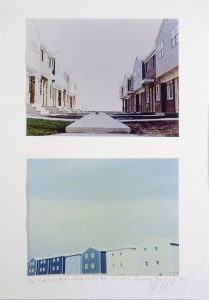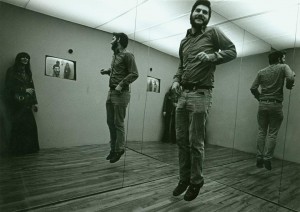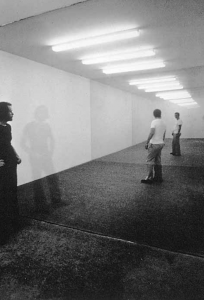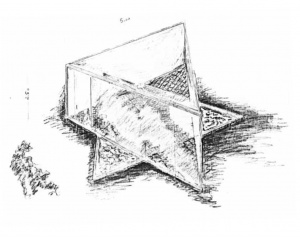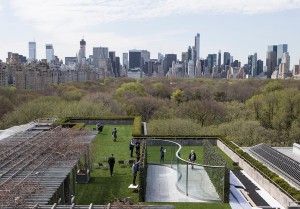Dan Graham
Homes for America
1966-67
Arts Magazine
Homes for America is a series of images outlining a typology of all possible variations on decorative motifs or materials. Through the photographs, Graham draws a critical parallel between the housing industry and the seriality inherited from the aesthetic of Minimal Art. It was not art about the media (like Pop Art) but art as media, art as information.
Dan Graham
Present Continuous Past(s)
1974
Installation
Collection du Musée national d’art moderne
This artwork is a room with mirrored walls, a video camera and a screen below the camera. The mirrors reflect present time, and the video camera tapes what is immediately in front of it and the entire reflection on the opposite mirrored wall. It has 3 major characteristics, 1) Interactive – the audience completes the artwork by entering the room and appearing on the screen; 2) Captures multiple perspectives, unlike paintings which are still images; 3) Time-space distortion created by the time lag: time as a dimension that can be experienced in space.
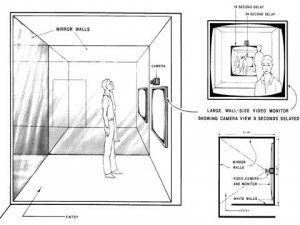
Dan Graham
Performer/Audience/Mirror
1975
22:52 min
b&w, sound
Performer/Audience/Mirror documenting a performance where Graham narrates his movements, the appearances of his viewers, and his own appearance in a mirror. This work is a phenomenological inquiry into the audience/performer relationship and the notion of subjectivity/objectivity. Graham stands in front of a mirrored wall facing a seated audience; he describes the audience’s movements and what they signify. He then turns and describes himself and the audience in the mirror.
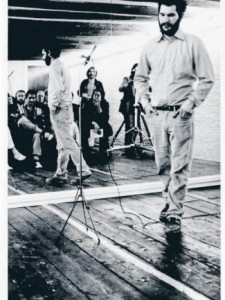
Dan Graham performing Performer/Audience/Mirror, 1977;
at de Appel arts centre, Amsterdam.
Photo courtesy the artist.
Dan Graham
Public Space/Two Audiences
1976
Installation
“Ambiente/Arte,” Venice Biennale
This work inaugurated a new approach by Graham to time delay: a dizzy perception postponed, an opportunity to observe a stranger, albeit only for an instant, before recognizing the stranger as oneself. The artificiality of the video and of the projectors, aided by mirrors and showcases, had enabled Dan Graham to explore perceptive dimensions that were in no way dependent on Renaissance perspective.
Dan Graham
Star of David Pavilion
1989
Drawing by the Artist
Dan Graham
Star of David Pavilion
1989-1996
two-way mirror, aluminum, Plexiglas
Schloss Buchberg, Austria
102 3/4 x 165 2/5 x 94 in
Graham’s Star of David Pavilion conveys the giddy sensation, setting off a continuous circular process, even in the visitor’s absolutely static state while the space begins to rotate, absorbed or rejected by the screens with which the volume is constructed. In reality, the deception begins precisely with our attempt to grasp the complexity of the structure, the exact intersection of its planes and the geometry of its space.
Dan Graham with Günther Vogt
Hedge Two-Way Mirror Walkabout
2014
Installation
The Metropolitan Museum of Art, New York
The Hedge Two-Way Mirror Walkabout, where the idyllic expanse of Central Park confronts the tall buildings of midtown Manhattan, is both of the city and at a certain remove from it. The evergreen plantings that edge the parapets also remind Graham of the shrubbery that often demarcates property lines in the New Jersey suburbs of his youth.
